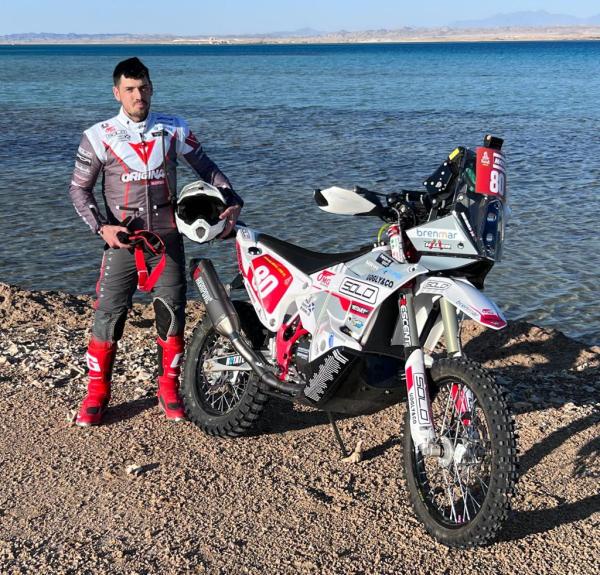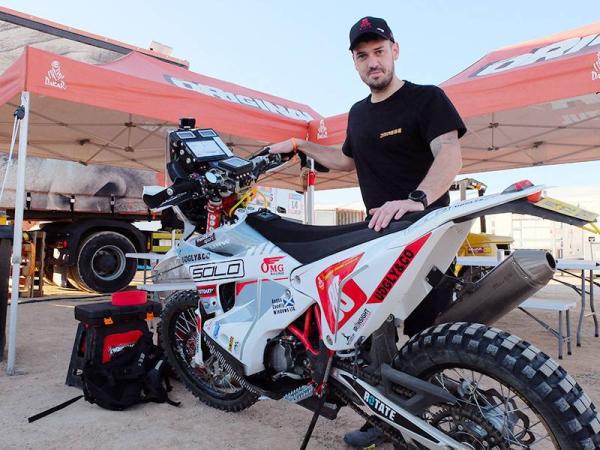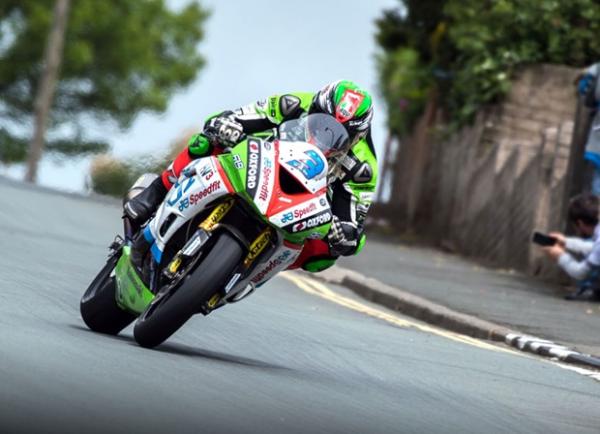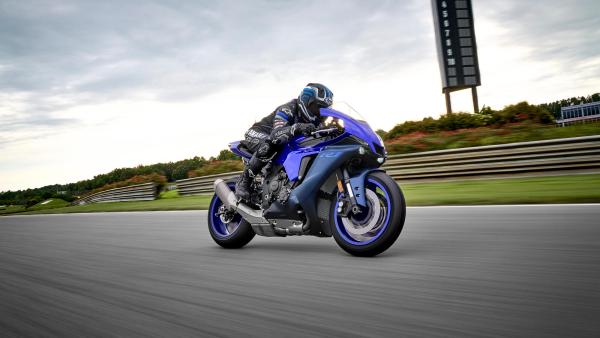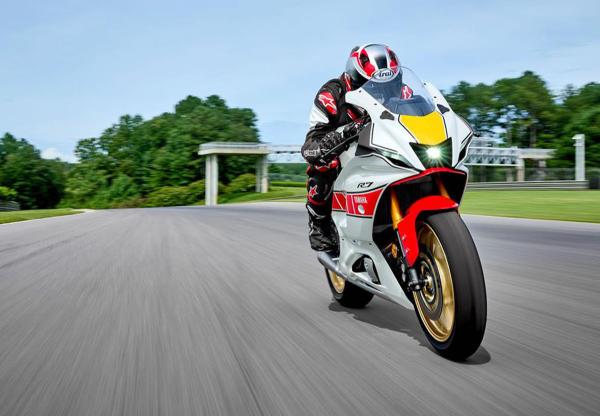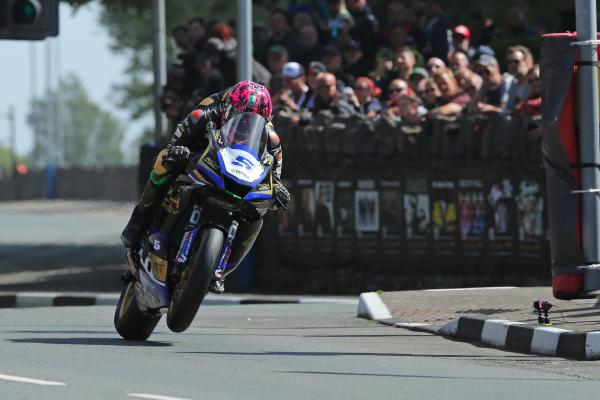EXCLUSIVE: James Hillier "could feel the grisly bone movement" after Dakar crash
TT veteran James Hillier spoke to Visordown the week after he returned from Saudi Arabia to talk Dakar, road racing, and preparing road bikes for the track.

Member for
54 years 8 monthsThe 2023 Dakar Rally will go down in history for many reasons. A fifth win for Nasser Al-Attiyah in the car category was certainly no mean feat, even if all of his primary rivals suffered mechanical problems and/or punctures. On two wheels, Kevin Benavides took his second Dakar win, and heading into the final stage only 12 seconds separated him and Red Bull KTM Factory Racing teammate Toby Price.
Part 1 - 2023 Dakar Rally
Another piece of motorcycle sport history was conducted by James Hillier, who rode a GasGas 450RX. The rider who wore #80 in the 2023 Dakar became the first person in history to compete in the Dakar Rally having previously won a race at the Isle of Man TT races.
Hillier’s TT debut came in 2008. “The TT was a real shock to the system with the sheer speed of things,” Hillier told Visordown. In comparison, “the Dakar was more of a shock with the sheer scale of [the event]. Obviously, the length of the stages and liaisons, but also the scale of the whole event.
“I can’t explain how impressive it is, in terms of the size of the entries, the bivouac, the paddock - it’s like nothing I’ve seen before [because] they [manage] to move it across Saudi Arabia to different locations.
The scale of the event did not lead to chaos, though, as Hillier explained. “With the size of it, it never really felt unorganised- always felt quite clear as to what was where and what was coming the next day. It was all a big, impressive organisation, to be honest.”
From the outside, it is possible to see similarities between the TT and the Dakar. Both events take place over two weeks (although on the Isle of Man only in the second week do the results become meaningful), both see riders setting off alone, and both present a fearsome challenge of riding skill as well as self-control. So, had Hillier’s road racing experience helped him in Saudi Arabia?
“No, not really,” he laughed. “Not a lot crossed over in terms of ability or experience. It was a very new experience for me in every way, really.
“But I suppose the loneliness when you’re out on the bike, which is the same at the TT- obviously [at the TT] the races are shorter [than a Dakar stage] - but [...] I quite like that loneliness, but it’s just you and the motorbike. That’s quite a nice familiarity between the two, I think.”
Another familiarity is the danger. It is presented in different ways in road racing and the Dakar. In road racing - and particularly with the TT where the track is so long, but it is also true of other races on shorter, but similarly or exceedingly fast circuits compared to Snaefell - the danger is presented through the challenge of the course, the speed, and the proximity and quantity of trackside objects. On the Dakar, the speed is less than the TT, but the danger remains high due to the lack of knowledge the riders have of the route they are riding, which - combined with the technical challenge that route provides - means the risk of injury is significant.
Hillier discovered the reality of the Dakar’s ability to bite on the rally’s fifth stage. He fell around 100km from the finish of the stage, and dislodged his collarbone from its attachment point in his shoulder.
The day before, on the fourth stage, Hillier had set his airbag off in a crash transitioning from a hard-pack track to a softer, sandier terrain. He described it as “a big crash,” but got away with it. On the fifth stage, he was less fortunate.
“But, the next day, I had been pushing on a bit in the morning with a group of riders. I wouldn’t say I was riding too quick, but I was riding sort of close to my limit of ability, and that sort of ‘risk management’, and being close to having a silly crash and hurting myself.
“So, we refuel halfway through that stage, [and after the refuel] I sort of rolled off, tapped out, and was riding my own at a steady pace.
“I just tipped over a small-ish dune, but on the other side - as I tucked the front wheel - it was real soft sand so the bike just sort of stopped. So it was a small, silly kind of fall, over- not even fully over the handlebars, just over the side of the bike. But [I] fell down and instead of putting my arm out I kind of landed on my shoulder and felt a crack, and that horrible, sick feeling that something is broken.
“I managed to pick the bike up and carry on, but I knew that my shoulder was on fire, I knew that something was damaged badly because I could feel it moving- the grisly bone movement. And I rode genuinely in tears because of the pain, and the emotional pain, I suppose, because I thought the rally was over - I thought I’d snapped my collarbone and that was the end of the rally. But I was determined to finish the stage, at least.”
When Hillier reached the end of the stage, he went to see the doctors. An X-ray confirmed he had not snapped his collarbone as he feared, but instead had dislocated it from his shoulder. “My first question was, ‘can I continue?’ And they said ‘well, if you can deal with the pain then yes.’
“So, obviously I had to give it a go, and once I’d done one day I knew I could do the rest of the rally, because I sort of proved to myself that I could do that directly afterwards. I needed a bit of help getting dressed in the morning, but it worked enough to ride. I had to sit down a lot more, because that made [the collarbone] a lot more stable. Those rally bikes also run a steering damper, so I turned the steering damper up quite a lot, and just tried to ride ‘reserved’ as best I could.”
His crash also necessitated a change in Hillier’s approach to the rally. Instead of riding alone, he sought support from other riders.
On the day after his crash, day six of the rally, Hillier began riding with Gareth Jones, who is originally from the UK but now lives in Canada.
“[Gareth Jones] was starting [stage 6] behind me, and I said to him on the start, ‘if you see me drop the bike somewhere, please could you help me pick it up?’ Because I genuinely was not in a state to be able to pick the bike up by myself.
“We spent the rest of the rally together, to be honest, rode together, and he did actually have to help me a few times to pick the bike up, but we sort of shared it together and experienced it together.”
Riding with Jones and trying to be more conservative with his riding to protect his collarbone saw Hillier’s pace drop off. Despite the pain, the drop in pace “helped me enjoy the rally a little bit more,” he said.
The Dakar features every year what is called a ‘Marathon Stage’. This stage is split in two and contested over two days, with riders not able to receive external assistance, and with things like tyre changes restricted. Hillier and Jones both rode in the Malle Moto, or Original by Motul, class, where this is essentially the case for the whole rally - all the bike work must be done by the rider in a designated area of the bivouac, with no outside assistance from a team. The Marathon, then, sort of brings the factory riders, and the others outside the Malle Moto class, into their realm for a couple of days.
Hillier explained that while the Marathon created extra challenges for the factory riders, for the Malle Moto competitors it was actually a slightly easier time.
“For the [Malle Moto class],” Hillier said, “the Marathon Stage was actually a better day because you couldn’t change tyres or anything like that. So, I just got off the bike, checked the spokes, went and got food, got changed, set my tent up and just went to sleep. I slept from 2pm until 6pm, so four hours in the afternoon; and then woke up, had dinner and went back to bed. [So], that Marathon, really, was probably the easiest bit for me to be honest, physically and mentally, because in that Malle class that was a rest, really.”
The challenge of the Malle Moto class was especially highlighted on the penultimate day. 10 days after his collarbone-dislodging crash on the fifth stage, Hillier had the end in sight at the end of the 13th stage. However, a tight chain link had damaged the rear tyre, so both the chain and tyre had to be replaced. “I thought I was over the hill and I wasn't going to do a lot on the bike that day,” Hillier said.
But, by that point the rally had prepared him for such a disappointment. “I think from day two or three,” Hillier said, “ I learned quite quickly that I just had to almost be prepared for the worst.
“There were a few times early on where I thought ‘I can’t get more cold than this,’ or ‘I’m not going to get more tired than this.’ But then something happens and it just gets worse and worse. You definitely find new levels of your mentality.
“There were a lot of times where I thought I was cold. But then I went even further, you know, because there's no choice. You have to do it. You know, you can't just pull over and say ‘I'm cold, I need a rest,’ because the sooner you get it done, the sooner you can get back and then actually warm up and get the work done ready for the next day. It was definitely a test of determination.”
Having now completed one Dakar - with difficult conditions, a not insignificant injury, and in arguably the most gruelling category - does Hillier want to return?
“I think during the rally I thought ‘I’m doing this and never doing it again’. [But] towards the end of the rally, I was sort of thinking [about] what I would do differently if I did it again.
“Then, on the plane on the way home I actually wrote a list of what I would need if I did it again that same way.
“I would definitely consider a four-wheel experience, for sure. I’m not saying that’s easy- it concerned me a little bit in four wheels that I’d have a false sense of security with the roll cage and seat belts. It would be a little bit of a different feeling [compared to the bike], because on the bike you’re pretty much always on standby to get badly hurt.
“I’m not saying you can’t hurt yourself in the car, but you’ve obviously got less chance of hurting yourself too badly in the car, [but] on the bike things can change very quickly.
“I think a car would be an experience I’d like to do one day, maybe - or a truck, or a buggy.
“So, I’m glad I’ve got it in the bank that I did it the hardest way possible first. So, in theory, it shouldn’t get any worse than that.”
Part 2 - TT plans & Crescent Yamaha
The Dakar was undoubtedly a diversion from the competition with which Hillier is most-commonly associated.
His aforementioned TT debut came in 2008, meaning the 2023 Isle of Man TT will be Hillier’s 14th year on the world’s most famous road race.
The past few seasons has seen Hillier compete with the OMG Racing team, which ran Yamahas in 2022 and will continue to do so in 2023.
Hillier competed in Saudi Arabia under the OMG team name, but the situation was not as simple as it seemed from the timing sheets and entry list.
“The original plan was to go with [OMG support],” Hillier said, “with the truck and mechanics. But that plan [fell through], and they pulled out, basically [because] they didn’t have the budget to run like they wanted to.
“So, I took the reins and sort of ran it myself. It should have been ‘James Hillier Racing’ on the entry of the bike.”
OMG’s recent switch to Yamaha - which was a part of their championship-winning BSB campaign in 2022 with Bradley Ray - after periods with Suzuki and BMW also works with Hillier’s career away from the races, where he works as a technical consultant at Crescent Yamaha - whose racing department is the team behind Yamaha’s WorldSBK success.
“So, basically, when a customer comes in for a track bike build, I sit down with them and go through where they’re wanting to go with the bike and [to] what level [they want to take it].”
Unsurprisingly, the majority of the bikes that arrive at Crescent looking to be made into more of a track-oriented machine are Yamaha R1s. But, there are also other models which are becoming increasingly popular.
“Definitely R1s [are the most popular], some R6s, but I think the R7, actually, is going to become very popular. We’ve been doing a bit of [work on R7s] recently. I don’t think [the R7] quite on the radar yet, but as a track bike I think it’s a great little bike, [...] I think there’s a lot of potential in those for track day riders.”
It had been announced recently that Michael Rutter will be giving the Yamaha R7 its debut in the Supertwins class at the 2023 Isle of Man TT.
As for Hillier’s own TT, recovering the strength in his damaged collarbone in the next months will be important. Progress there is already underway.
“Pretty sore, still,” Hillier said about his collarbone. “I’m just trying to rest it as much as I can, obviously [at the Dakar], it didn’t get any chance to fix itself [but] I think it somewhat stabilised fairly quickly, because it had to. [But, right now], I’m just trying not to use it too much, just a bit of swimming and [working on] manoeuvrability - not really any strain or lifting.”
